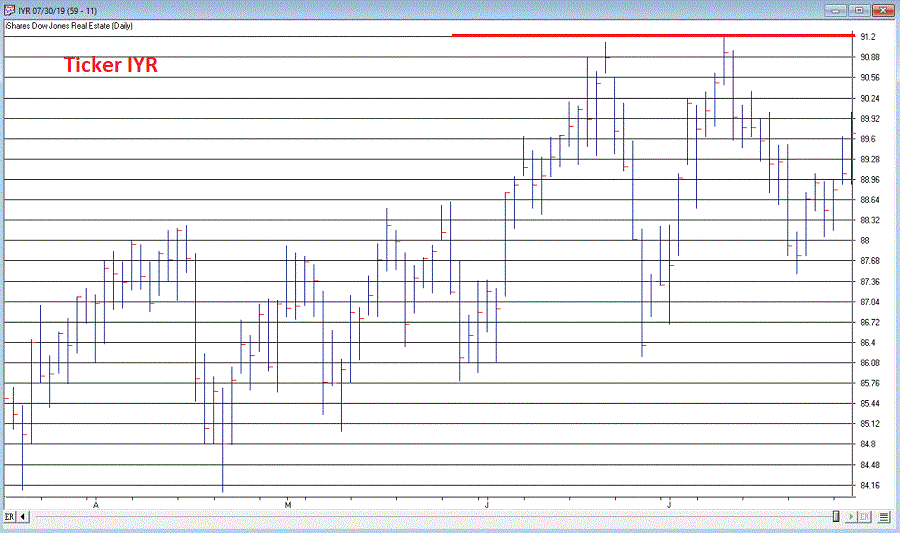In this article I wrote about the fact that August through November is something of a “Dead Zone” for real estate stocks. Of course, with any seasonal trend there is always the chance that “this time around” will be “the exception to the rule.”
Still let’s look at one hypothetical potential play.
The Caveat
As always, what follows is not intended to be a trade recommendation. I don’t give advice nor make recommendations as this site is intended to be strictly “educational.” But a working example can be helpful in illustrating what investors might consider when looking for trades to play certain situations.
The Situation
Based on a) a weak seasonal trend and, b) overhead resistance in ticker IYR, we will look for a trade that can make money as long as IYR does anything except rally strongly in the weeks ahead.
Figure 1 displays a bar char for ticker IYR. You can see the overhead resistance for yourself. See Figure 2 in this article for information on the unfavorable seasonal period.
 Figure 1 – Ticker IYR with the “Line in the Sand” (Courtesy AIQ TradingExpert)
Figure 1 – Ticker IYR with the “Line in the Sand” (Courtesy AIQ TradingExpert)
So, we are looking for an opportunity to make money if IYR does NOT rally strongly prior to the end of September. One possibility is the example trade highlighted in Figures 2and 3, which involves:
*Selling 1 IYR Oct 94 call
*Buying 1 IYR Oct 99 call
Because these options are not heavily traded one would likely want to place a limit order and try to get filled at the midpoint of the bid/ask range rather than simply placing a market order. Figure 2 displays the particulars. Figure 2 – IYR Bear Call Spread (Courtesy www.OptionsAnalysis.com)
Figure 2 – IYR Bear Call Spread (Courtesy www.OptionsAnalysis.com)
Figure 3 displays the risk curves assuming that the trade is held until expiration on October 18th.
 Figure 3 – IYR Bear Call spread risk curves (Courtesy www.OptionsAnalysis.com)
Figure 3 – IYR Bear Call spread risk curves (Courtesy www.OptionsAnalysis.com)
For a 1-lot:
*Maximum profit potential = $36 (13.64% of capital risked)
*Maximum risk = (-$264)
*At expiration the position will show a profit with IYR at any price below $94.36 a share
*At expiration the trade will earn the maximum profit of $36 if IYR is at $94 or below
*The maximum loss of -$264 would only occur if we held the position until expiration and IYT was at or above $99 a share at that time. Clearly, we need a plan to make sure that that does not happen.
The Plan
Our plan is to hold this trade no longer than through the end of October. So, to get a better idea of “where this trade lives”, we will change the risk curve chart so that the last line is drawn as of 9/30/2019 (i.e., with 18 days left until expiration.
Figure 4 – Adjusting risk curve settings to “where this trade lives” (Courtesy www.OptionsAnalysis.com)
Likewise, this trade essentially hinges on the idea that IYR will NOT break out to the upside. So, in terms of stop-loss it makes sense to consider a price not too far above the recent high of $91.22 a share.
In Figure 5 we see that if we use $92.50 as a stop-loss point, then if IYR were to rally immediately to that price we would exit with a loss of roughly -$56 on a 1-lot. Figure 5 – “Zoomed in” risk curves (Courtesy www.OptionsAnalysis.com)
Figure 5 – “Zoomed in” risk curves (Courtesy www.OptionsAnalysis.com)
Another alternative would be to make the stop-loss price something above the breakeven price of $94.36. The tradeoff in doing so is:
a) You increase the probability that the trade will NOT be stopped out
b) You increase the amount that will be lost if the stop-loss is hit (i.e., if IYR hits say $94.50, the loss could be over $100 on a 1-lot.
In a nutshell:
*a stop at $92.50 has a higher likelihood of being hit, but results in a smaller loss
*a stop-loss at $94.50 has a lower likelihood of being hit, but results in a larger loss.
There is no “right” or “wrong” choice – each trader must decide where their priorities lie.
Summary
Repeating now: I am not making any predictions regarding ticker IYR nor am I “recommending” the trade above. The bear call spread detailed above is presented merely as an example of one way to “stack several factors” – in this case, a weak seasonal trend plus an obvious “line in the sand” as overhead resistance.
Jay Kaeppel
Disclaimer: The data presented herein were obtained from various third-party sources. While I believe the data to be reliable, no representation is made as to, and no responsibility, warranty or liability is accepted for the accuracy or completeness of such information. The information, opinions and ideas expressed herein are for informational and educational purposes only and do not constitute and should not be construed as investment advice, an advertisement or offering of investment advisory services, or an offer to sell or a solicitation to buy any security.

